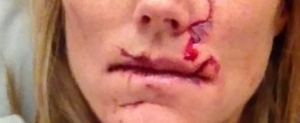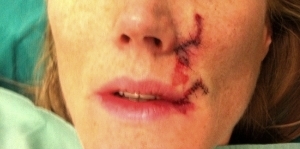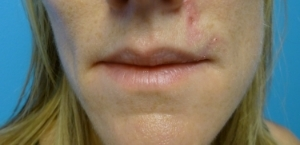I was interviewed by Jane Oddy about scar treatment for an article in today’s Daily Mirror (17th March, page 33). It followed an interview with Lorraine Kelly about a riding accident that resulted in a horrific injury to her leg. Here are some points about how to get the best scar outcome following an injury.
Getting appropriate treatment at the time of injury is critical to outcome. To produce a fine neat scar, the wounds edges need to be clean (all dirt and devitalised tissue removed) and accurately opposed with no tension. On the face, this is achieved with fine sutures.

EXAMPLE OF NASTY FACIAL LACERATION WITH MULTIPLE SEPARATE CUTS

IMMEDIATELY AFTER WOUND CLOSURE
Once healed, there are certain measures that can be performed to improve the final scar appearance. These include daily massage and application of moisturising cream, silicone gel or sheets (e.g. Dermatix) . Certain areas (limbs, earlobes) are amenable to pressure dressings, which have been shown to reduce scar thickening. Occasionally, injection of steroid into the scar may be indicated.

10 DAYS AFTER INJURY. THE SUTURES WERE REMOVED AFTER 5 DAYS.
The scar maturation process takes 12-18 months. Once mature, a scar revision may be considered if there are ongoing issues with appearance (thick, lumps, unsightly) or function (pain, loss of movement). Scar revision is a surgical procedure that aims to improve the scar appearance using different techniques:
- Scar excision. Removing the old scar and closing the wound again may help if the original wound was very dirty at the time of injury.
- Scar realignment. Realigning scars so that they lie in natural skin creases where they are less visible. This is particularly useful on the face.
- Break up straight scars. Linear scars are very conspicuous and can be made less visible by adding small zigzags.
- Fat grafting. In cases where there are contour irregularities, injecting fat underneath the scar can improve the overall appearance.